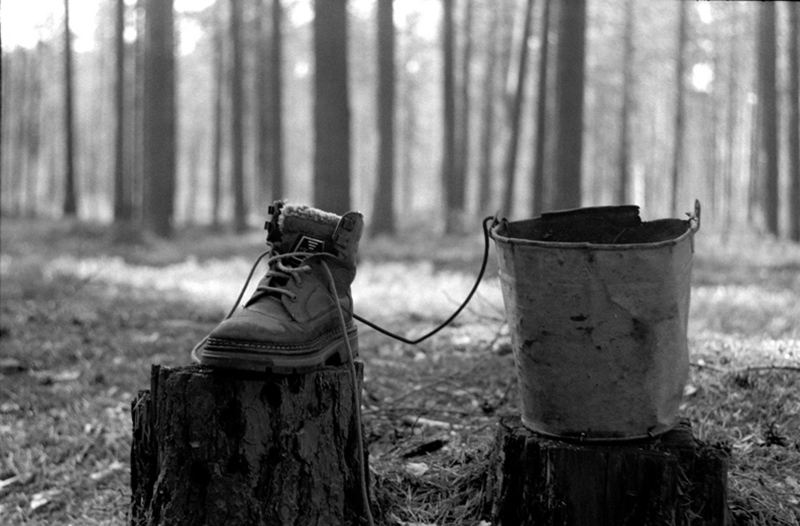Let me tell you a story.
It’s kind of like Jack and Jill went up the hill, but this time, there’s just Jack…
And the hill is optional.
As soon as Jack reaches the well, he fills his pail of water just below the brim. It’s a long walk home, so he trudges along, but doesn’t notice that he is leaving a trail of water behind him.
When he reaches home, he sees that his pail is now only half full (or half empty, if that’s your philosophy). What in the world happened? Jack empties the water into his reservoir and inspects the pail. There are no holes that he can see.
Just to be sure, he dips the pail in the reservoir to fill it up, and holds it above the tank to see what’s going on – and he discovers that tiny drops are leaking from places where he can’t even discern there is a hole.
But drops are falling. So he decides to patch the pail up as best as he can, and from then on, his water-fetching becomes much, much more efficient.
You’ve probably figured out where I am going with this, right?
You and I, we are both Jack. Day in and day out, we work on our business. We collect money from our customers (the well), and use our business – online stores or presences – to do so. But before this money reaches our pockets (the reservoir), it’s suddenly a lot less than what we thought.
So what’s up? Could it be that our ecommerce stores are leaky buckets?
Be smart with expenses
The first and most important rule of not having a leaky bucket is to make sure you are keeping track of all of your expenses!
Keeping track doesn’t just mean clumping all of your expenses into one entry – keeping track means being specific.
How much did you spend on apps?
How much did you spend on advertising?
How much did you spend on content marketing?
Ask yourself about all the expenses you have. Labor, packaging materials, overhead, design… anything.
If you don’t keep track like this, know that the first step to fixing leaks is finding them. For this month, open up a spreadsheet and enter all of your expenses. Remember, you don’t have to cut these expenses just because you listed them here. This is just for you to better understand where your money is going.
Control your startup costs
A lot of times, buckets will leak because we puncture them ourselves before we start out. It’s very easy to get caught up in the moment and excitement of starting a new business and then spending a lot of money where it doesn’t need to be spent.
Do you really need…
…that $10,000 design at this stage? Or could you make do with something a little simpler for now, and upgrade when necessary?
…so many consultants on board, or can you read up and learn some of the ropes yourself? You’re smart, so study and get the experience yourself. It will pay off!
…10 shiny apps, or can just a few essential ones get you by for now?
…to decorate your office right now, or will your bedroom/living room/garage suffice for now?
…full-time employees right now, or can you get the same work done by outsourcing?
Prioritize your tools
A lot of buckets (stores) leak money because they have unnecessary apps installed. 99% of apps are an overhead, which means you’ve got to pay the bills no matter whether you make a sale or not.
This is not to say that you should start letting go of all apps. Some apps are essential to your business – especially ones that handle your multichannel inventory control, shipping, and even accounting.
But are you on the right plan? If your business is just starting out, you don’t need to be on the enterprise plan – you could do well with the basic or silver plan.
The next level of priority is customer retention apps. These apps are a little tricky – they are really important – in fact, Richard Lazazzera writes how these apps can prevent leaky buckets. After all, you are spending money and going through a lot of effort to bring customers to your store, so you should take every measure to make sure you are getting as much value from each visitor as possible.
But, if you’ve got an app(or apps) that are not delivering any ROI and are just costing money, then perhaps this is not the best time to keep that app on board.
For example, on my store, I had a couple of apps installed. This was a highly bootstrapped store, so budget was tight. I was hoping that PPC would bring some good traffic, but PPC did not work for me, so I decided to focus more on SEO.
But that meant that I would no longer be getting regular visitors for quite a while, at least until my SEO efforts paid off after the 4-6 months it takes for that to take effect. So I decided to stop running those apps for the time being, just to save on the overheads.
Once my traffic comes back to a good point(through SEO or other channels, too), I’ll sign up for those apps again.
The beauty of apps is that it takes just a few moments to set them up, it takes just a few moments to uninstall them, and in just another few moments, you can use them again!
Revisit your PPC campaigns
PPC campaigns are a huge money pit if you don’t know what you are doing. Google and other ad networks are just waiting for you to make these classic newbie mistakes so they can capitalize on your credit card.
Before you start your PPC campaign, make sure you have an idea of how PPC and how keywords work! Covering how to run a budget PPC campaign is out of the scope of this post, but you can check out this excellent guide by Dennis Moons.
Even if you have a good ppc campaign running, it may prove fruitful to see what ad groups or keywords are not performing well consistently and pause them instead.
If you haven’t done this already, make sure you have conversion tracking set up! If you can’t track conversions, there is no way you can know which ad or which keyword is bringing you the sale. You may as well be burning your money.
Taking a scalpel to your campaigns isn’t the only way, though. If your ads are doing consistently well, it may be worth decreasing your bids by 10 or 15% to see if that doesn’t hurt the amount of clicks you are getting. If it doesn’t, great! Otherwise just increase your bids again.
Finally, optimizing your PPC campaign can decrease your costs in the long run. The higher click-through rate your ads have and the higher relevance they have to your actual page, the lower you end up paying – so if you are bidding high to drive traffic right now, focus on optimizing to lower your cost per click.
You’d be surprised how much money you can save!
What about things you can’t measure?
Everything these days is about measuring, measuring, and more measuring. But you know better than anyone else that there are certain things you just can’t measure, like social media ROI.
For those things, you just have to make a decision with your gut – is it something you really need to spend so much on right now? Or can you scale back the expenses a bit?
Unfortunately, there’s no way to really tell. You can try to do a quick cost-benefit analysis by thinking of these expenses as long-term investments instead of something you’d expect an immediate return on.
So go ahead. Give it a shot. See where you bucket is leaky, and fix those leaks!



3 thoughts on “Is Your Ecommerce Store A Leaky Bucket?”
Right on the money 😉 Pun intended. So often we just start throwing everything at our growth, when in reality, if we plugged the leaks, we wouldn’t need to push to hard to just keep things moving forward.
Right on the money 😉 Pun intended. So often we just start throwing everything at our growth, when in reality, if we plugged the leaks, we wouldn’t need to push to hard to just keep things moving forward.
Right on the money 😉 Pun intended. So often we just start throwing everything at our growth, when in reality, if we plugged the leaks, we wouldn’t need to push to hard to just keep things moving forward.
Comments are closed.